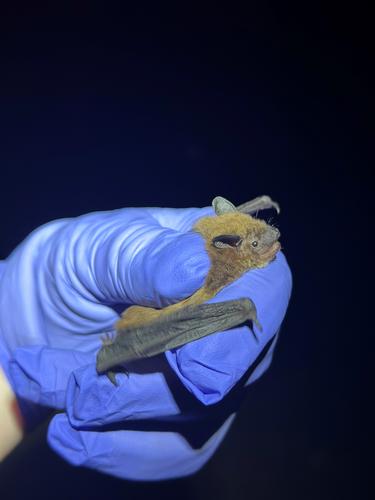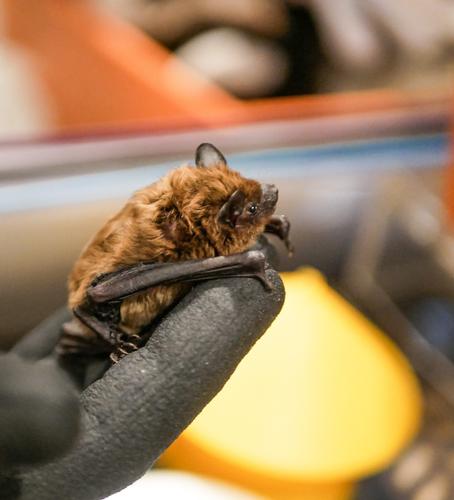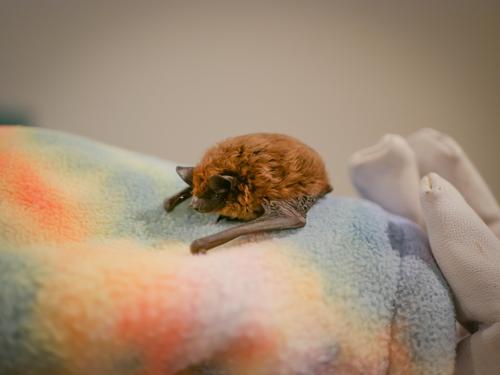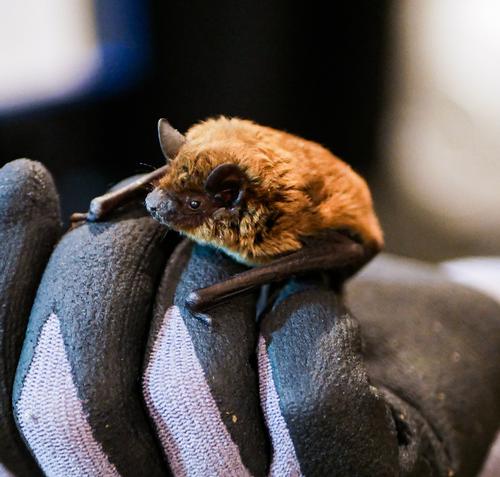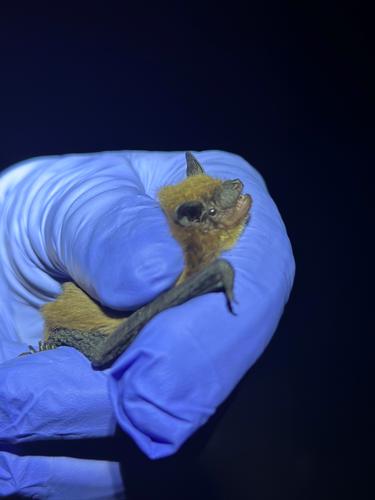Plants and Animals
Nycticeius humeralis Evening bat
Key Characteristics
The evening bat reaches an average length of 3.6 inches, with both forearm and tail measuring about 1.5 inches. Hair is sparse and dark brown, with individual hairs being black at the base, while the underside is of a much lighter shade. Wings, tail, muzzle and small ears are thick, leathery and black. This bat is distinguished from other similar species by its rounded, forward curving tragus (skin flap at front of ear) and number of upper incisors (two instead of four). As the evening bat forages for insects both high and low to the ground, its flight pattern is slow and steady.
Status and Rank
US Status: No Status/Not Listed
State Status: T - Threatened (legally protected)
Global Rank: G5 - Secure
State Rank: S2 - Imperiled
Occurrences
| County | Number of Occurrences | Year Last Observed |
|---|---|---|
| Lenawee | 1 | 2007 |
Information is summarized from MNFI's database of rare species and community occurrences. Data may not reflect true distribution since much of the state has not been thoroughly surveyed.
Habitat
In old and mature forests, this species prefers to roost behind loose bark during the nonbreeding season, frequently moving between large snags located near one another, and in spacious cavities during the maternity period (Kunz and Lumsden 2003, Pierson 1998, Texas Parks and Wildlife Department 1999). Where such conditions are not available, evening bats will roost in wooden structures, such as attics and barns. Foraging habitat includes open areas above water and forest clearings and edges.
Specific Habitat Needs
Snag/cavity needed in: Dry southern forest; Dry-mesic southern forest; Mesic southern forest.
Natural Community Types
For each species, lists of natural communities were derived from review of the nearly 6,500 element occurrences in the MNFI database, in addition to herbarium label data for some taxa. In most cases, at least one specimen record exists for each listed natural community. For certain taxa, especially poorly collected or extirpated species of prairie and savanna habitats, natural community lists were derived from inferences from collection sites and habitat preferences in immediately adjacent states (particularly Indiana and Illinois). Natural communities are not listed for those species documented only from altered or ruderal habitats in Michigan, especially for taxa that occur in a variety of habitats outside of the state.
Natural communities are not listed in order of frequency of occurrence, but are rather derived from the full set of natural communities, organized by Ecological Group. In many cases, the general habitat descriptions should provide greater clarity and direction to the surveyor. In future versions of the Rare Species Explorer, we hope to incorporate natural community fidelity ranks for each taxon.
Management Recommendations
Management for evening and other tree-roosting bats involves protecting large stands of old-growth and mature forest, especially those in close proximity to water, as well as retaining snags and older living trees within these stands (Miles et al. 2006, Pierson 1998). As thriving insect populations are necessary for many bat species, including the evening bat, insecticide applications may have dramatic negative impacts. Healthy aquatic habitats are required by bats, both as sources of clean drinking water and to produce multitudes of insect prey items, while open areas above water provide important foraging grounds (Hayes and Loeb 2007).
Active Period
Breeding from first week of October to fourth week of October
Parturition from third week of May to second week of June
Survey Methods
The most widely used survey method for forest-dwelling bats is evening and night time mist netting within the travel corridors of suitable habitat. Visual surveys at known roosts with good visibility, such as buildings and bridges, can also be used (Weller 2007).
Mist netting
Survey Period: From second week of May to second week of August
Time of Day: Night
Visual surveys
Survey Period: From second week of May to second week of August
Time of Day: Daytime
Survey Method Comment: at known, accessible roost
References
Survey References
- Weller, T.J. 2007. Assessing Population Status of Bats in Forests: Challenges and Opportunities. Pp. 263-291 in: Lacki, M.J., J.P. Hayes and A. Kurta (eds). 2007. Bats in Forests: Conservation and Management. Johns Hopkins University Press, Baltimore. 329pp.
Technical References
- Davis, W.B. and D.J. Schmidly. 1997. Evening Bat. The Mammals of Texas, Online Edition. Texas Tech University. Available online at http://www.nsrl.ttu.edu/tmot1/nycthume.htm [Accessed Sept. 15, 2011].
- Hayes, J.P. and S.C. Loeb. 2007. The Influence of Forest Management on Bats in North America. Pp. 206-235 in: Lacki, M.J., J.P. Hayes and A. Kurta (eds.). 2007. Bats in Forests: Conservation and Management. The Johns Hopkins University Press, Baltimore. 329pp.
- Kunz, T.H. and L.F. Lumsden. 2003. Ecology of Cavity and Foliage Roosting Bats. Pp. 3-89 in: Kunz, T.H. and M.B. Fenton (eds.). 2003. Bat Ecology. The University of Chicago Press, Chicago. 779 pp.
- Miles, A.C., S.B. Castleberry, D.A. Miller and L.M. Conner. 2006. Multi-Scale Roost-Site Selection by Evening Bats on Pine-Dominated Landscapes in Southwest Georgia. Journal of Wildlife Management 70(5):1191-1199.
- Pierson, E.D. 1998. Tall Trees, Deep Holes, and Scarred Landscapes: Conservation Biology of North American Bats. Pp. 309-325 in: Kunz, T.A. and P.A. Racey (eds.). 1998. Bat Biology and Conservation. Smithsonian Institution Press, Washington D.C. 365pp.
- Texas Parks and Wildlife Department. 1999. Evening Bat (Nycticeius humeralis). Available online at http://www.tpwd.state.tx.us/huntwild/wild/species/evening/ [Accessed Sept. 15, 2011].


